views
History and Origin of Tequila
Tequila has a unique history originating from the Mexican state of Jalisco. It is believed that indigenous tribes in Mexico were the first to ferment the juices from the hearts of blue agave plants. After harvesting the hearts, indigenous people would roast them in underground pits lined with hot rocks before crushing them and allowing their juices to ferment. The Spanish conquistadors discovered this indigenous spirit in the 16th century and began refining the process. In the late 19th century, tequila production and trade was well established with factories known as tequileras starting mass production of tequila. Today, tequila must be produced in specific regions of Mexico, especially the state of Jalisco, in order to be called tequila and receive an official certification.
Types of Tequila
Tequila are four main categories of tequila based on the production process: blanco or plata, reposado, añejo, and extra añejo. Blanco or plata tequila is unaged and crystal clear. It retains most of the agave flavor profile. Reposado tequila is aged in oak barrels from 2 months to under a year, taking on some caramel color and oak vanilla flavors. Añejo tequila is aged between 1 and 3 years, becoming a dark gold color with sweeter oak and dried fruit flavors. Extra añejo tequila is aged over 3 years, becoming an amber or brown color with complex molasses and caramel notes.
The Production Process
Tequila production begins with harvesting mature blue agave plants that are 7-10 years old. Their large heart or piña is roasted in earthen ovens called hornos for two to three days to halt enzymatic and fermentation processes. The cooked piñas are then shipped to mills where they are crushed and shredded to extract their juice, called agave syrup or mosto. Yeast is added to the must and it ferments for 1-4 days. The resulting liquid is distilled twice to increase the alcohol content. The clear liquid is then either bottled as blanco tequila or aged.
Tasting Tequila
When tasting tequila, the best approach is to start with blanco tequila to experience the pure agave flavors before exploring the effects of aging. Swirl the tequila gently in a brandy snifter and appreciate the aromas of cooked agave. Notice hints of soil, grass, pepper or citrus notes. Then take a sip and feel the coarse texture from the agave fibers followed by sweet saps and subtle vegetal flavors across the tongue. With reposado and añejo tequilas, look for oak influences like caramel, vanilla, or dried fruit layered with residual agave flavors that become smoother with age. Extra añejo tequilas offer an opportunity to taste history in the bottle through their super smooth texture and complexity.
Popular Uses of Tequila
Beyond being sipped neat or on the rocks, tequila is a key ingredient in many classic cocktails. The Margarita is perhaps the most popular tequila cocktail blending it with lime juice and orange liqueur. Other classic tequila drinks include the Paloma combining tequila with grapefruit soda and lime, and the Tequila Sunrise with orange juice and grenadine. For an after dinner digestif, try sipping a neat extra añejo in a snifter. In Mexican culture, tequila shots are often accompanied by a dash of salt placed on the back of the hand or wrist, followed by a squeeze of lime in the shot. No matter how you choose to enjoy tequila, its crisp agave character and inherent ability to transport your tastebuds to Mexico make it a unique and engaging spirit.
About Author:
Money Singh is a seasoned content writer with over four years of experience in the market research sector. Her expertise spans various industries, including food and beverages, biotechnology, chemical and materials, defense and aerospace, consumer goods, etc. (https://www.linkedin.com/in/money-singh-590844163)






















Comments
0 comment